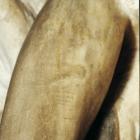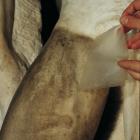In 1999, a complex project of extraordinary maintenance got underway on the Rondanini Pietà, with the aim of improving its state of conservation, restoring brightness to the marble and bringing out the quality of the shaped areas and the character of the workmanship.
Completed in 2005, this lengthy project was carried out thanks to an intense and fruitful interdisciplinary collaboration between the Institute for the Conservation and Promotion of Cultural Heritage (the then Centre of the National Research Council "Gino Bozza), the Central Institute of restoration and various researchers and scientists from a number of Italian universities.
The work was tackled in two stages: the first a diagnosis to determine the state of conservation, the second a cleaning operation.
Diagnostic analyses
The first phase began with the close observation of the surfaces, a collection of micro-samples of foreign substances to the marble and photogrammetric surveys, which provided structural and metric verification models. At a later stage, in parallel to the documentary research, a campaign of scientific investigation was undertaken that allowed the substances superimposed upon the marble to be recognised. This step was fundamental in identifying the systems needed to intervene upon the work and highlight the threats to the future preservation of the Pietà.
The cleaning
The final phase was that of the cleaning; by removing the patina that covered almost the entire surface, as well as dust deposited over time, it was possible to bring the Pietà, which fortunately had not been subjected to “destructive” restorations over the centuries, to its original splendor.
On the occasion of the Rondanini Pietà’s transferal to the new museum in 2015, yet another new and lighter cleansing of the marble surfaces was undertaken in accordance with the methodological protocols established during the previous restoration work.










